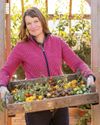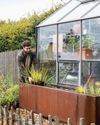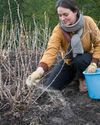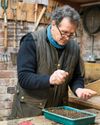
Everyone's going wild for rewilding. You can see it on unmown road verges newly billowing with cow parsley and in the gardens of stately homes where previously manicured lawns are now shaggy and alive with wildflowers. It's even got its own storyline in The Archers.
Rewilding is all about letting nature take back control. It's about standing back, putting away the mower and the hand fork for a while, and letting grasses and wildflowers self-seed as they will. In rewilded gardens you allow dead material to return to the ground, locking in carbon (and helping to combat climate change), letting your garden's natural biodiversity find its own balance and thrive.
It turns much of what we thought we knew about gardening on its head. So with the help of leading rewilding pioneers we've put together your guide to the steps you can take to release your garden's inner wild child.
Large and small scale
At first, rewilding seems to have little to do with gardens. When pioneering environmental charity Rewilding Britain says it wants five percent of the UK returned to the wild, it's talking national parks: big-sky solutions to save our vanishing wildlife, chased out by urban sprawl and intensive farming.
Large-scale rewilding lets woodlands and grasslands regenerate without human interference. It also reintroduces lost wildlife to maintain habitats naturally. Longhorn cattle roam the rewilded farmland at Knepp Castle in Sussex and beavers are back in rivers from Devon to Scotland after 400 years. Their dams could reduce flooding by 60 percent, according to a study* reported by the Beaver Trust.
Diese Geschichte stammt aus der August 2022-Ausgabe von Gardeners World.
Starten Sie Ihre 7-tägige kostenlose Testversion von Magzter GOLD, um auf Tausende kuratierte Premium-Storys sowie über 8.000 Zeitschriften und Zeitungen zuzugreifen.
Bereits Abonnent ? Anmelden
Diese Geschichte stammt aus der August 2022-Ausgabe von Gardeners World.
Starten Sie Ihre 7-tägige kostenlose Testversion von Magzter GOLD, um auf Tausende kuratierte Premium-Storys sowie über 8.000 Zeitschriften und Zeitungen zuzugreifen.
Bereits Abonnent? Anmelden

Sweet pickings
What are the best cordon cherry tomatoes to grow? Lucy Chamberlain tested a dozen varieties to find the sweetest, juiciest and heaviest cropping options for the season ahead

ON TEST Mini chainsaws
Take the strain out of pruning trees and shrubs with a handy, battery-powered, mini chainsaw. Harry Duncton puts six products to the test to see if they make the cut

DIY garden projects
To end his series, Henry Agg explains how to make a rainwater pond filled with aquatic plants

Act now for wildlife
Gardeners across the UK have been stepping up to support wildlife and combat related issues such as climate change. GW Wildlife Editor Kate Bradbury reveals the results of this year's review, celebrating successes and exploring how we can all help

Make the most of your kitchen garden
Getting out into the garden in winter, even for short spells, keeps things ticking over, especially fruit and veg crops, as Adam Frost explains

YOUR PRUNING MONTH
February is a great time to prune many garden plants, from herbaceous perennials to holly topiary, says Frances Tophill

Garden globetrotting Seville
With the cross-cultural architecture of its buildings and the gardens' diverse planting, the Real Alcázar de Sevilla has so much to offer visitors that Matt Collins has to resort to his diary to recall its every detail

Potting on a winter show
Nick Bailey saves the best till last, ending his winter container series with a vibrant display packed with plants in rich plums and silver

Growing THE GOOD LIFE
Join urban smallholder Sara Ward as she begins the month with a few key jobs for the year ahead

Sowing for Success
Start your growing year on the right footing with Monty's timely guide to sowing a garden full of colour and flavour